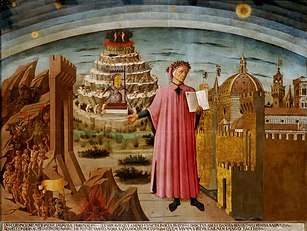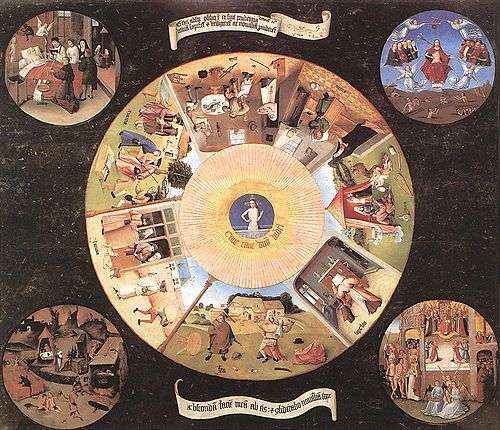Divine Comedy
The Divine Comedy (Italian: Divina Commedia [diˈviːna komˈmɛːdja]) is a long Italian narrative poem by Dante Alighieri, begun c. 1308 and completed in 1320, a year before his death in 1321. It is widely considered to be the pre-eminent work in Italian literature[1] and one of the greatest works of world literature.[2] The poem's imaginative vision of the afterlife is representative of the medieval world-view as it had developed in the Western Church by the 14th century. It helped establish the Tuscan language, in which it is written (also in most present-day Italian-market editions), as the standardized Italian language.[3] It is divided into three parts: Inferno, Purgatorio, and Paradiso.
| This article is part of the series on the |
| Italian language |
|---|
| History |
| Literature and other |
| Grammar |
| Alphabet |
| Phonology |
The narrative takes as its literal subject the state of souls after death and presents an image of divine justice meted out as due punishment or reward,[4] and describes Dante's travels through Hell, Purgatory, and Paradise or Heaven,[5] while allegorically the poem represents the soul's journey towards God,[6] beginning with the recognition and rejection of sin (Inferno), followed by the penitent Christian life (Purgatorio), which is then followed by the soul's ascent to God (Paradiso). Dante draws on medieval Roman Catholic[7][8][9][10][11] theology and philosophy, especially Thomistic philosophy derived from the Summa Theologica of Thomas Aquinas.[12] Consequently, the Divine Comedy has been called "the Summa in verse".[13] In Dante's work,[14] the pilgrim Dante is accompanied by three guides:[4] Virgil (who represents human reason),[15] Beatrice (who represents divine revelation,[16] theology, faith, and grace),[17] and Saint Bernard of Clairvaux (who represents contemplative mysticism and devotion to Mary).[18]
The work was originally simply titled Comedìa (pronounced [komeˈdiːa]; so also in the first printed edition, published in 1472), Tuscan for "Comedy", later adjusted to the modern Italian Commedia. The adjective Divina was added by Giovanni Boccaccio, and the first edition to name the poem Divina Comedia in the title was that of the Venetian humanist Lodovico Dolce,[19] published in 1555 by Gabriele Giolito de' Ferrari.
Structure and story
The Divine Comedy is composed of 14,233 lines that are divided into three cantiche (singular cantica) – Inferno (Hell), Purgatorio (Purgatory), and Paradiso (Paradise) – each consisting of 33 cantos (Italian plural canti). An initial canto, serving as an introduction to the poem and generally considered to be part of the first cantica, brings the total number of cantos to 100. It is generally accepted, however, that the first two cantos serve as a unitary prologue to the entire epic, and that the opening two cantos of each cantica serve as prologues to each of the three cantiche.[20][21][22]
The number three is prominent in the work (alluding to the Trinity), represented in part by the number of cantiche and their lengths. Additionally, the verse scheme used, terza rima, is hendecasyllabic (lines of eleven syllables), with the lines composing tercets according to the rhyme scheme aba, bcb, cdc, ded, ....[23] The total number of syllables in each tercet is thus 33, the same as the number of cantos in each cantica.
Written in the first person, the poem tells of Dante's journey through the three realms of the dead, lasting from the night before Good Friday to the Wednesday after Easter in the spring of 1300. The Roman poet Virgil guides him through Hell and Purgatory; Beatrice, Dante's ideal woman, guides him through Heaven. Beatrice was a Florentine woman he had met in childhood and admired from afar in the mode of the then-fashionable courtly love tradition, which is highlighted in Dante's earlier work La Vita Nuova.[24]
The structure of the three realms follows a common numerical pattern of 9 plus 1, for a total of 10: 9 circles of the Inferno, followed by Lucifer contained at its bottom; 9 rings of Mount Purgatory, followed by the Garden of Eden crowning its summit; and the 9 celestial bodies of Paradiso, followed by the Empyrean containing the very essence of God. Within each group of 9, 7 elements correspond to a specific moral scheme, subdivided into three subcategories, while 2 others of greater particularity are added to total nine. For example, the seven deadly sins of the Catholic Church that are cleansed in Purgatory are joined by special realms for the late repentant and the excommunicated by the church. The core seven sins within Purgatory correspond to a moral scheme of love perverted, subdivided into three groups corresponding to excessive love (Lust, Gluttony, Greed), deficient love (Sloth), and malicious love (Wrath, Envy, Pride).[25]
In central Italy's political struggle between Guelphs and Ghibellines, Dante was part of the Guelphs, who in general favored the Papacy over the Holy Roman Emperor. Florence's Guelphs split into factions around 1300 – the White Guelphs and the Black Guelphs. Dante was among the White Guelphs who were exiled in 1302 by the Lord-Mayor Cante de' Gabrielli di Gubbio, after troops under Charles of Valois entered the city, at the request of Pope Boniface VIII, who supported the Black Guelphs. This exile, which lasted the rest of Dante's life, shows its influence in many parts of the Comedy, from prophecies of Dante's exile to Dante's views of politics, to the eternal damnation of some of his opponents.[26]
The last word in each of the three cantiche is stelle ("stars").
Inferno
.jpg)
The poem begins on the night before Good Friday in 1300, "halfway along our life's path" (Nel mezzo del cammin di nostra vita). Dante is thirty-five years old, half of the biblical lifespan of 70 (Psalms 89:10, Vulgate), lost in a dark wood (understood as sin),[27][28][29] assailed by beasts (a lion, a leopard, and a she-wolf) he cannot evade and unable to find the "straight way" (diritta via) – also translatable as "right way" – to salvation (symbolized by the sun behind the mountain). Conscious that he is ruining himself and that he is falling into a "low place" (basso loco) where the sun is silent ('l sol tace), Dante is at last rescued by Virgil, and the two of them begin their journey to the underworld. Each sin's punishment in Inferno is a contrapasso, a symbolic instance of poetic justice; for example, in Canto XX, fortune-tellers and soothsayers must walk with their heads on backwards, unable to see what is ahead, because that was what they had tried to do in life:
they had their faces twisted toward their haunches
and found it necessary to walk backward,
because they could not see ahead of them.
... and since he wanted so to see ahead,
he looks behind and walks a backward path.[30]
Allegorically, the Inferno represents the Christian soul seeing sin for what it really is, and the three beasts represent three types of sin: the self-indulgent, the violent, and the malicious.[31] These three types of sin also provide the three main divisions of Dante's Hell: Upper Hell, outside the city of Dis, for the four sins of indulgence (lust, gluttony, avarice, anger); Circle 7 for the sins of violence; and Circles 8 and 9 for the sins of fraud and treachery. Added to these are two unlike categories that are specifically spiritual: Limbo, in Circle 1, contains the virtuous pagans who were not sinful but were ignorant of Christ, and Circle 6 contains the heretics who contradicted the doctrine and confused the spirit of Christ.[32]
Purgatorio
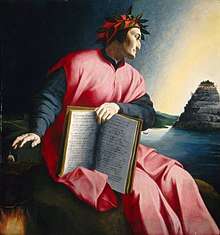
Having survived the depths of Hell, Dante and Virgil ascend out of the undergloom to the Mountain of Purgatory on the far side of the world. The Mountain is on an island, the only land in the Southern Hemisphere, created by the displacement of rock which resulted when Satan's fall created Hell[33] (which Dante portrays as existing underneath Jerusalem[34]). The mountain has seven terraces, corresponding to the seven deadly sins or "seven roots of sinfulness."[35] The classification of sin here is more psychological than that of the Inferno, being based on motives, rather than actions. It is also drawn primarily from Christian theology, rather than from classical sources.[36] However, Dante's illustrative examples of sin and virtue draw on classical sources as well as on the Bible and on contemporary events.
Love, a theme throughout the Divine Comedy, is particularly important for the framing of sin on the Mountain of Purgatory. While the love that flows from God is pure, it can become sinful as it flows through humanity. Humans can sin by using love towards improper or malicious ends (Wrath, Envy, Pride), or using it to proper ends but with love that is either not strong enough (Sloth) or love that is too strong (Lust, Gluttony, Greed). Below the seven purges of the soul is the Ante-Purgatory, containing the Excommunicated from the church and the Late repentant who died, often violently, before receiving rites. Thus the total comes to nine, with the addition of the Garden of Eden at the summit, equaling ten.[37]
Allegorically, the Purgatorio represents the Christian life. Christian souls arrive escorted by an angel, singing In exitu Israel de Aegypto. In his Letter to Cangrande, Dante explains that this reference to Israel leaving Egypt refers both to the redemption of Christ and to "the conversion of the soul from the sorrow and misery of sin to the state of grace."[38] Appropriately, therefore, it is Easter Sunday when Dante and Virgil arrive.
The Purgatorio is notable for demonstrating the medieval knowledge of a spherical Earth. During the poem, Dante discusses the different stars visible in the southern hemisphere, the altered position of the sun, and the various time zones of the Earth. At this stage it is, Dante says, sunset at Jerusalem, midnight on the River Ganges, and sunrise in Purgatory.
Paradiso
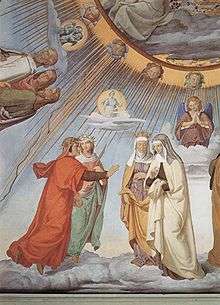
After an initial ascension, Beatrice guides Dante through the nine celestial spheres of Heaven. These are concentric and spherical, as in Aristotelian and Ptolemaic cosmology. While the structures of the Inferno and Purgatorio were based on different classifications of sin, the structure of the Paradiso is based on the four cardinal virtues and the three theological virtues.
The seven lowest spheres of Heaven deal solely with the cardinal virtues of Prudence, Fortitude, Justice and Temperance. The first three spheres involve a deficiency of one of the cardinal virtues – the Moon, containing the inconstant, whose vows to God waned as the moon and thus lack fortitude; Mercury, containing the ambitious, who were virtuous for glory and thus lacked justice; and Venus, containing the lovers, whose love was directed towards another than God and thus lacked Temperance. The final four incidentally are positive examples of the cardinal virtues, all led on by the Sun, containing the prudent, whose wisdom lighted the way for the other virtues, to which the others are bound (constituting a category on its own). Mars contains the men of fortitude who died in the cause of Christianity; Jupiter contains the kings of Justice; and Saturn contains the temperate, the monks who abided by the contemplative lifestyle. The seven subdivided into three are raised further by two more categories: the eighth sphere of the fixed stars that contain those who achieved the theological virtues of faith, hope and love, and represent the Church Triumphant – the total perfection of humanity, cleansed of all the sins and carrying all the virtues of heaven; and the ninth circle, or Primum Mobile (corresponding to the Geocentricism of Medieval astronomy), which contains the angels, creatures never poisoned by original sin. Topping them all is the Empyrean, which contains the essence of God, completing the 9-fold division to 10.
Dante meets and converses with several great saints of the Church, including Thomas Aquinas, Bonaventure, Saint Peter, and St. John. The Paradiso is consequently more theological in nature than the Inferno and the Purgatorio. However, Dante admits that the vision of heaven he receives is merely the one his human eyes permit him to see, and thus the vision of heaven found in the Cantos is Dante's personal vision.
The Divine Comedy finishes with Dante seeing the Triune God. In a flash of understanding that he cannot express, Dante finally understands the mystery of Christ's divinity and humanity, and his soul becomes aligned with God's love:[39]
But already my desire and my will
were being turned like a wheel, all at one speed,
by the Love which moves the sun and the other stars.[40]
History
Manuscripts
According to the Italian Dante Society, no original manuscript written by Dante has survived, although there are many manuscript copies from the 14th and 15th centuries – some 800 are listed on their site.[41]
Early printed editions
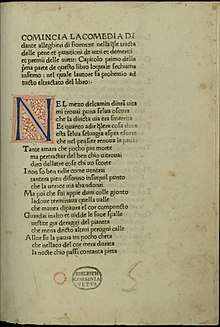
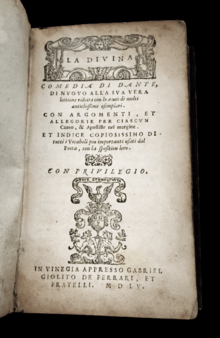
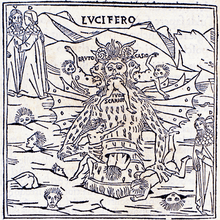
The first printed edition was published in Foligno, Italy, by Johann Numeister and Evangelista Angelini da Trevi on 11 April 1472.[42] Of the 300 copies printed, fourteen still survive. The original printing press is on display in the Oratorio della Nunziatella in Foligno.
| Date | Title | Place | Publisher | Notes |
|---|---|---|---|---|
| 1472 | La Comedia di Dante Alleghieri | Foligno | Johann Numeister and Evangelista Angelini da Trevi | First printed edition (or editio princeps) |
| 1477 | La Commedia | Venice | Wendelin of Speyer | |
| 1481 | Comento di Christophoro Landino fiorentino sopra la Comedia di Dante Alighieri | Florence | Nicolaus Laurentii | With Cristoforo Landino's commentary in Italian, and some engraved illustrations by Baccio Baldini after designs by Sandro Botticelli |
| 1491 | Comento di Christophoro Landino fiorentino sopra la Comedia di Dante Alighieri | Venice | Pietro di Piasi | First fully illustrated edition |
| 1502 | Le terze rime di Dante | Venice | Aldus Manutius | |
| 1506 | Commedia di Dante insieme con uno diagolo circa el sito forma et misure dello inferno | Florence | Philippo di Giunta | |
| 1555 | La Divina Comedia di Dante | Venice | Gabriel Giolito | First use of "Divine" in title |
Thematic concerns
The Divine Comedy can be described simply as an allegory: each canto, and the episodes therein, can contain many alternative meanings. Dante's allegory, however, is more complex, and, in explaining how to read the poem – see the Letter to Cangrande[43] – he outlines other levels of meaning besides the allegory: the historical, the moral, the literal, and the anagogical.
The structure of the poem is also quite complex, with mathematical and numerological patterns distributed throughout the work, particularly threes and nines, which are related to the Holy Trinity. The poem is often lauded for its particularly human qualities: Dante's skillful delineation of the characters he encounters in Hell, Purgatory, and Paradise; his bitter denunciations of Florentine and Italian politics; and his powerful poetic imagination. Dante's use of real characters, according to Dorothy Sayers in her introduction to her translation of the Inferno, allows Dante the freedom of not having to involve the reader in description, and allows him to "[make] room in his poem for the discussion of a great many subjects of the utmost importance, thus widening its range and increasing its variety."[44]
Dante called the poem "Comedy" (the adjective "Divine" was added later, in the 16th century) because poems in the ancient world were classified as High ("Tragedy") or Low ("Comedy").[45] Low poems had happy endings and were written in everyday language, whereas High poems treated more serious matters and were written in an elevated style. Dante was one of the first in the Middle Ages to write of a serious subject, the Redemption of humanity, in the low and "vulgar" Italian language and not the Latin one might expect for such a serious topic. Boccaccio's account that an early version of the poem was begun by Dante in Latin is still controversial.[46][47]
Scientific themes
Although the Divine Comedy is primarily a religious poem, discussing sin, virtue, and theology, Dante also discusses several elements of the science of his day (this mixture of science with poetry has received both praise and criticism over the centuries[48]). The Purgatorio repeatedly refers to the implications of a spherical Earth, such as the different stars visible in the southern hemisphere, the altered position of the sun, and the various time zones of the Earth. For example, at sunset in Purgatory it is midnight at the Ebro, dawn in Jerusalem, and noon on the River Ganges:[49]
Just as, there where its Maker shed His blood,
the sun shed its first rays, and Ebro lay
beneath high Libra, and the ninth hour's rays
were scorching Ganges' waves; so here, the sun
stood at the point of day's departure when
God's angel – happy – showed himself to us.[50]
Dante travels through the centre of the Earth in the Inferno, and comments on the resulting change in the direction of gravity in Canto XXXIV (lines 76–120). A little earlier (XXXIII, 102–105), he queries the existence of wind in the frozen inner circle of hell, since it has no temperature differentials.[51]
Inevitably, given its setting, the Paradiso discusses astronomy extensively, but in the Ptolemaic sense. The Paradiso also discusses the importance of the experimental method in science, with a detailed example in lines 94–105 of Canto II:
Yet an experiment, were you to try it,
could free you from your cavil and the source
of your arts' course springs from experiment.
Taking three mirrors, place a pair of them
at equal distance from you; set the third
midway between those two, but farther back.
Then, turning toward them, at your back have placed
a light that kindles those three mirrors and
returns to you, reflected by them all.
Although the image in the farthest glass
will be of lesser size, there you will see
that it must match the brightness of the rest.[52]
A briefer example occurs in Canto XV of the Purgatorio (lines 16–21), where Dante points out that both theory and experiment confirm that the angle of incidence is equal to the angle of reflection. Other references to science in the Paradiso include descriptions of clockwork in Canto XXIV (lines 13–18), and Thales' theorem about triangles in Canto XIII (lines 101–102).
Galileo Galilei is known to have lectured on the Inferno, and it has been suggested that the poem may have influenced some of Galileo's own ideas regarding mechanics.[53]
Theories of influence from Islamic philosophy
In 1919, Miguel Asín Palacios, a Spanish scholar and a Catholic priest, published La Escatología musulmana en la Divina Comedia (Islamic Eschatology in the Divine Comedy), an account of parallels between early Islamic philosophy and the Divine Comedy. Palacios argued that Dante derived many features of and episodes about the hereafter from the spiritual writings of Ibn Arabi and from the Isra and Mi'raj or night journey of Muhammad to heaven. The latter is described in the ahadith and the Kitab al Miraj (translated into Latin in 1264 or shortly before[54] as Liber Scalae Machometi, "The Book of Muhammad's Ladder"), and has significant similarities to the Paradiso, such as a sevenfold division of Paradise, although this is not unique to the Kitab al Miraj or Islamic cosmology.[55]
Some "superficial similarities"[56] of the Divine Comedy to the Resalat Al-Ghufran or Epistle of Forgiveness of Al-Ma'arri have also been mentioned in this debate. The Resalat Al-Ghufran describes the journey of the poet in the realms of the afterlife and includes dialogue with people in Heaven and Hell, although, unlike the Kitab al Miraj, there is little description of these locations,[57] and it is unlikely that Dante borrowed from this work.[58][59]
Dante did, however, live in a Europe of substantial literary and philosophical contact with the Muslim world, encouraged by such factors as Averroism ("Averrois, che'l gran comento feo" Commedia, Inferno, IV, 144, meaning "Averrois, who wrote the great comment") and the patronage of Alfonso X of Castile. Of the twelve wise men Dante meets in Canto X of the Paradiso, Thomas Aquinas and, even more so, Siger of Brabant were strongly influenced by Arabic commentators on Aristotle.[60] Medieval Christian mysticism also shared the Neoplatonic influence of Sufis such as Ibn Arabi. Philosopher Frederick Copleston argued in 1950 that Dante's respectful treatment of Averroes, Avicenna, and Siger of Brabant indicates his acknowledgement of a "considerable debt" to Islamic philosophy.[60]
Although this philosophical influence is generally acknowledged, many scholars have not been satisfied that Dante was influenced by the Kitab al Miraj. The 20th century Orientalist Francesco Gabrieli expressed skepticism regarding the claimed similarities, and the lack of evidence of a vehicle through which it could have been transmitted to Dante. Even so, while dismissing the probability of some influences posited in Palacios' work,[61] Gabrieli conceded that it was "at least possible, if not probable, that Dante may have known the Liber Scalae and have taken from it certain images and concepts of Muslim eschatology". Shortly before her death, the Italian philologist Maria Corti pointed out that, during his stay at the court of Alfonso X, Dante's mentor Brunetto Latini met Bonaventura de Siena, a Tuscan who had translated the Kitab al Miraj from Arabic into Latin. Corti speculates that Brunetto may have provided a copy of that work to Dante.[62] René Guénon, a Sufi convert and scholar of Ibn Arabi, rejected in The Esoterism of Dante the theory of his influence (direct or indirect) on Dante.[63] Palacios' theory that Dante was influenced by Ibn Arabi was satirized by the Turkish academic Orhan Pamuk in his novel The Black Book.[64]
Literary influence in the English-speaking world and beyond
_-_WGA02855.jpg)
The Divine Comedy was not always as well-regarded as it is today. Although recognized as a masterpiece in the centuries immediately following its publication,[65] the work was largely ignored during the Enlightenment, with some notable exceptions such as Vittorio Alfieri; Antoine de Rivarol, who translated the Inferno into French; and Giambattista Vico, who in the Scienza nuova and in the Giudizio su Dante inaugurated what would later become the romantic reappraisal of Dante, juxtaposing him to Homer.[66] The Comedy was "rediscovered" in the English-speaking world by William Blake – who illustrated several passages of the epic – and the Romantic writers of the 19th century. Later authors such as T. S. Eliot, Ezra Pound, Samuel Beckett, C. S. Lewis and James Joyce have drawn on it for inspiration. The poet Henry Wadsworth Longfellow was its first American translator,[67] and modern poets, including Seamus Heaney,[68] Robert Pinsky, John Ciardi, W. S. Merwin, and Stanley Lombardo, have also produced translations of all or parts of the book. In Russia, beyond Pushkin's translation of a few tercets,[69] Osip Mandelstam's late poetry has been said to bear the mark of a "tormented meditation" on the Comedy.[70] In 1934, Mandelstam gave a modern reading of the poem in his labyrinthine "Conversation on Dante".[71] In T. S. Eliot's estimation, "Dante and Shakespeare divide the world between them. There is no third."[72] For Jorge Luis Borges the Divine Comedy was "the best book literature has achieved".[73]
English translations
New English translations of the Divine Comedy continue to be published regularly. Notable English translations of the complete poem include the following.[74]
| Year | Translator | Notes |
|---|---|---|
| 1805–1814 | Henry Francis Cary | An older translation, widely available online. |
| 1867 | Henry Wadsworth Longfellow | Unrhymed terzines. The first U.S. translation, raising American interest in the poem. It is still widely available, including online. |
| 1891–1892 | Charles Eliot Norton | Prose translation used by Great Books of the Western World. Available online at Project Gutenberg. |
| 1933–1943 | Laurence Binyon | Terza rima. Translated with assistance from Ezra Pound |
| 1949–1962 | Dorothy L. Sayers | Translated for Penguin Classics, intended for a wider audience, and completed by Barbara Reynolds. |
| 1969 | Thomas G. Bergin | Cast in blank verse with illustrations by Leonard Baskin.[75] |
| 1954–1970 | John Ciardi | His Inferno was recorded and released by Folkways Records in 1954. |
| 1970–1991 | Charles S. Singleton | Literal prose version with extensive commentary; 6 vols. |
| 1981 | C. H. Sisson | Available in Oxford World's Classics. |
| 1980–1984 | Allen Mandelbaum | Available online. |
| 1967–2002 | Mark Musa | An alternative Penguin Classics version. |
| 2000–2007 | Robert and Jean Hollander | Online as part of the Princeton Dante Project. |
| 2002–2004 | Anthony M. Esolen | Modern Library Classics edition. |
| 2006–2007 | Robin Kirkpatrick | A third Penguin Classics version, replacing Musa's. |
| 2010 | Burton Raffel | A Northwestern World Classics version. |
| 2013 | Clive James | A poetic version in quatrains. |
A number of other translators, such as Robert Pinsky, have translated the Inferno only.
In the arts
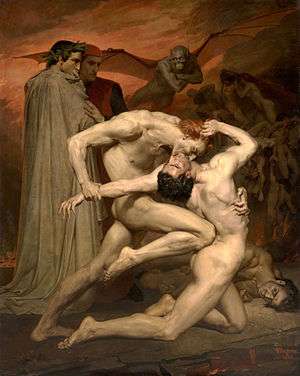
The Divine Comedy has been a source of inspiration for countless artists for almost seven centuries. There are many references to Dante's work in literature. In music, Franz Liszt was one of many composers to write works based on the Divine Comedy. In sculpture, the work of Auguste Rodin includes themes from Dante, and many visual artists have illustrated Dante's work, as shown by the examples above. There have also been many references to the Divine Comedy in cinema, television, digital arts, comics and video games.
Gallery
From Dialogo di Antonio Manetti, cittadino fiorentino, circa al sito, forma, et misure dello inferno di Dante Alighieri poeta excellentissimo (Florence: F. Giunta, 1510?)
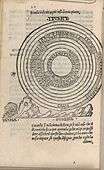 "Everything Reduced to One Plan", 1506
"Everything Reduced to One Plan", 1506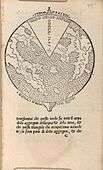 "The Chamber of Hell", 1506
"The Chamber of Hell", 1506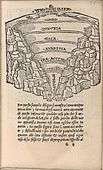 "Overview of Hell", 1506
"Overview of Hell", 1506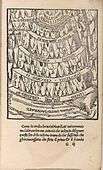 "The First Five Circles", 1506
"The First Five Circles", 1506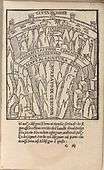 "Circles Six and Seven", 1506
"Circles Six and Seven", 1506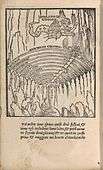 "The Lair of Geryon", 1506
"The Lair of Geryon", 1506 "The Tomb of Lucifer", 1506
"The Tomb of Lucifer", 1506
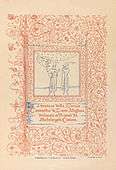 1855 title page
1855 title page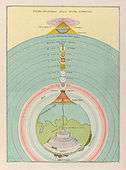 Plate I: "Overview of the Divine Comedy"
Plate I: "Overview of the Divine Comedy"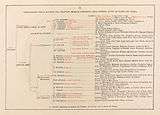 Plate II: "The Ordering of Hell"
Plate II: "The Ordering of Hell" Plate III: "Map of Hell"
Plate III: "Map of Hell" Plate IV: "Cross Section of Hell"
Plate IV: "Cross Section of Hell"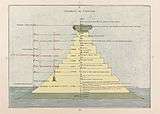 Plate V: "The Ordering of Purgatory"
Plate V: "The Ordering of Purgatory"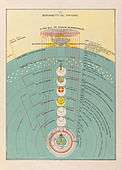 Plate VI: "The Ordering of Paradise"
Plate VI: "The Ordering of Paradise"
See also
- Allegory in the Middle Ages
- Book of Arda Viraf
- List of cultural references in Divine Comedy
- Paradise Lost
- Theological fiction
Citations
- For example, Encyclopedia Americana, 2006, Vol. 30. p. 605: "the greatest single work of Italian literature;" John Julius Norwich, The Italians: History, Art, and the Genius of a People, Abrams, 1983, p. 27: "his tremendous poem, still after six and a half centuries the supreme work of Italian literature, remains – after the legacy of ancient Rome – the grandest single element in the Italian heritage;" and Robert Reinhold Ergang, The Renaissance, Van Nostrand, 1967, p. 103: "Many literary historians regard the Divine Comedy as the greatest work of Italian literature. In world literature it is ranked as an epic poem of the highest order."
- Bloom, Harold (1994). The Western Canon. See also Western canon for other "canons" that include the Divine Comedy.
- See Lepschy, Laura; Lepschy, Giulio (1977). The Italian Language Today. or any other history of Italian language.
- Lansing, Richard. The Dante Encyclopedia. p. 181.
- Peter E. Bondanella, The Inferno, Introduction, p. xliii, Barnes & Noble Classics, 2003, ISBN 1-59308-051-4: "the key fiction of the Divine Comedy is that the poem is true."
- Dorothy L. Sayers, Hell, notes on page 19.
- Lansing, Richard. The Dante Encyclopedia. p. 273.
- Lansing, Richard. The Dante Encyclopedia. p. 481.
- Lansing, Richard. The Dante Encyclopedia. p. 298.
- Lansing, Richard. The Dante Encyclopedia. p. 214.
- Lansing, Richard. The Dante Encyclopedia. p. 56.
- Charles Allen Dinsmore, The Teachings of Dante (Ayer, 1970), p. 38, ISBN 0-8369-5521-8.
- The Fordham Monthly Fordham University, Vol. XL, Dec. 1921, p. 76
- Approaches to teaching Dante's Divine comedy. Slade, Carole., Cecchetti, Giovanni, 1922–1998. New York, N.Y.: Modern Language Association of America. 1982. ISBN 978-0873524780. OCLC 7671339.CS1 maint: others (link)
- Lansing, Richard. The Dante Encyvlopedia. p. 743.
- Lansing, Richard. The Dante Encyvlopedia. p. 743.
- Lansing, Richard. The Dante Encyclopedia. p. 93.
- Lansing, Richard. The Dante Encyclopedia. p. 99.
- Ronnie H. Terpening, Lodovico Dolce, Renaissance Man of Letters (Toronto, Buffalo, London: University of Toronto Press, 1997), p. 166.
- Dante The Inferno A Verse Translation by Professor Robert and Jean Hollander p. 43
- Epist. XIII 43 to 48
- Wilkins E.H The Prologue to the Divine Comedy Annual Report of the Dante Society, pp. 1–7.
- Kaske, Robert Earl, et al. Medieval Christian Literary Imagery: A Guide to Interpretation. Toronto: Toronto UP, 1988. p. 164
- Shaw 2014, pp. xx, 100–101, 108.
- Eiss 2017, p. 8.
- Trone 2000, pp. 362–364.
- "Inferno, la Divina Commedia annotata e commentata da Tommaso Di Salvo, Zanichelli, Bologna, 1985". Abebooks.it. Retrieved 16 January 2010.
- Lectura Dantis, Società dantesca italiana
- Online sources include , Archived 23 July 2011 at the Wayback Machine, , "Archived copy". Archived from the original on 2 December 2009. Retrieved 1 December 2009.CS1 maint: archived copy as title (link), Archived 4 March 2016 at the Wayback Machine
- Inferno, Canto XX, lines 13–15 and 38–39, Mandelbaum translation.
- Dorothy L. Sayers, Purgatory, notes on p. 75.
- Carlyle-Okey-Wicksteed, Divine Comedy, "Notes to Dante's Inferno"
- Inferno, Canto 34, lines 121–126.
- Richard Lansing and Teodolinda Barolini, The Dante Encyclopedia, p. 475, Garland Publishing, 2000, ISBN 0-8153-1659-3.
- Dorothy L. Sayers, Purgatory, Introduction, pp. 65–67 (Penguin, 1955).
- Robin Kirkpatrick, Purgatorio, Introduction, p. xiv (Penguin, 2007).
- Carlyle-Oakey-Wickstead, Divine Comedy, "Notes on Dante's Purgatory.
- "The Letter to Can Grande," in Literary Criticism of Dante Alighieri, translated and edited by Robert S. Haller (Lincoln: University of Nebraska Press, 1973), p. 99
- Dorothy L. Sayers, Paradise, notes on Canto XXXIII.
- Paradiso, Canto XXXIII, lines 142–145, C. H. Sisson translation.
- "Elenco Codici". Dante Online. Retrieved 5 August 2009.
- Christopher Kleinhenz, Medieval Italy: An Encyclopedia, Volume 1, Routledge, 2004, ISBN 0-415-93930-5, p. 360.
- "Epistle to Can Grande". faculty.georgetown.edu. Retrieved 20 October 2014.
- Dorothy L. Sayers, Hell, Introduction, p. 16 (Penguin, 1955).
- "Ancient History Encyclopedia".
- Boccaccio also quotes the initial triplet:"Ultima regna canam fluvido contermina mundo, / spiritibus quae lata patent, quae premia solvunt /pro meritis cuicumque suis". For translation and more, see Guyda Armstrong, Review of Giovanni Boccaccio. Life of Dante. J. G. Nichols, trans. London: Hesperus Press, 2002.
- Peri, Hiram (1955). "The Original Plan of the Divine Comedy". Journal of the Warburg and Courtauld Institutes. 18 (3/4): 189–210. doi:10.2307/750179. JSTOR 750179.
- Michael Caesar, Dante: The Critical Heritage, Routledge, 1995, pp. 288, 383, 412, 631.
- Dorothy L. Sayers, Purgatory, notes on p. 286
- Purgatorio, Canto XXVII, lines 1–6, Mandelbaum translation.
- Dorothy L. Sayers, Inferno, notes on p. 284.
- Paradiso, Canto II, lines 94–105, Mandelbaum translation.
- Peterson, Mark A. "Galileo's discovery of scaling laws". American Journal of Physics 70, 575 (2002). doi:10.1119/1.1475329.
- I. Heullant-Donat and M.-A. Polo de Beaulieu, "Histoire d'une traduction," in Le Livre de l'échelle de Mahomet, Latin edition and French translation by Gisèle Besson and Michèle Brossard-Dandré, Collection Lettres Gothiques, Le Livre de Poche, 1991, p. 22 with note 37.
- Uždavinys, Algis (2011). Ascent to Heaven in Islamic and Jewish Mysticism. Matheson Trust. pp. 23, 92–93, 117. ISBN 978-1908092021.
- William Montgomery Watt and Pierre Cachia, A History of Islamic Spain, 2nd edition, Edinburgh University Press, 1996, pp. 125–126, ISBN 0-7486-0847-8.
- Dionisius A. Agius and Richard Hitchcock, The Arab Influence in Medieval Europe, Ithaca Press, 1996, p. 70, ISBN 0-86372-213-X.
- Kāmil Kīlānī and G. Brackenbury, Introduction to Risalat ul Ghufran: A Divine Comedy, 3rd ed, Al-Maaref Printing and Publishing House, 1943, p. 8.
- The theory "receives little credence", according to Watt and Cachia, p. 183.
- Frederick Copleston (1950). A History of Philosophy, Volume 2. London: Continuum. p. 200.
- Francesco Gabrieli, "New light on Dante and Islam", Diogenes, 2:61–73, 1954
- "Errore". Archived from the original on 14 July 2014. Retrieved 7 September 2007.
- Guenon, René (1925). The Esoterism of Dante.
- Almond, Ian (2002). "The Honesty of the Perplexed: Derrida and Ibn 'Arabi on "Bewilderment"". Journal of the American Academy of Religion. 70 (3): 515–537. JSTOR 1466522.
- Chaucer wrote in the Monk's Tale, "Redeth the grete poete of Ytaille / That highte Dant, for he kan al devyse / Fro point to point; nat o word wol he faille".
- Erich Auerbach, Dante: Poet of the Secular World. ISBN 0-226-03205-1.
- Irmscher, Christoph. Longfellow Redux. University of Illinois, 2008: 11. ISBN 978-0-252-03063-5.
- Seamus Heaney, "Envies and Identifications: Dante and the Modern Poet." The Poet's Dante: Twentieth-Century Responses. Ed. Peter S. Hawkins and Rachel Jacoff. New York: Farrar, 2001. 239–258.
- 'Dante in Russia' in The Dante encyclopedia by Richard H. Lansing and Teodolinda Barolini,
- Glazova, Marina (November 1984). "Mandel'štam and Dante: The Divine Comedy in Mandel'štam's Poetry of the 1930s". Studies in Soviet Thought. 28 (4).
- James Fenton, Hell set to music, The Guardian, 16 July 2005
- T. S. Eliot (1950) "Dante." Selected Essays, pp. 199–237. New York: Harcourt, Brace and Company.
- Jorge Luis Borges, "Selected Non-Fictions". Ed. Eliot Weinberger. Trans. Esther Allen et. al. New York: Viking, 1999. 303.
- A comprehensive listing and criticism, covering the period 1782–1966, of English translations of at least one of the three cantiche is given by Gilbert F. Cunningham, The Divine Comedy in English: A Critical Bibliography, 2 vols. (New York: Barnes & Noble, 1965–67), esp. vol. 2, pp. 5–9.
- Dante Alighieri. Bergin, Thomas G. trans. Divine Comedy. Grossman Publishers; 1st edition (1969) .
- Le Normand-Romain, Antoinette (1999). Rodin:The Gates of Hell. Paris: Musée Rodin. ISBN 978-2-901428-69-5.
Bibliography
- Eiss, Harry (2017). Seeking God in the Works of T.S. Eliot and Michelangelo. New Castle upon Tyne: Cambridge Scholars. ISBN 978-1-44384-390-4.CS1 maint: ref=harv (link)
- Shaw, Prue (2014). Reading Dante: From Here to Eternity. New York: Liveright Publishing. ISBN 978-1-63149-006-4.CS1 maint: ref=harv (link)
- Trone, George Andrew (2000). "Exile". In Richard Lansing (ed.). The Dante Encyclopedia. London and New York: Routledge. ISBN 978-0-41587-611-7.CS1 maint: ref=harv (link)
Further reading
- Ziolkowski, Jan M. (2015). Dante and Islam. Fordham University Press, New York. ISBN 0823263878.
External links
| Wikiquote has quotations related to: Divine Comedy |
| Wikimedia Commons has media related to The Divine Comedy. |
| Wikisource has original text related to this article: |
- Princeton Dante Project Website that offers the complete text of the Divine Comedy (and Dante's other works) in Italian and English along with audio accompaniment in both languages. Includes historical and interpretive annotation.
- The Comedy in English: trans. Cary (with Doré's illustrations) (zipped HTML downloadable from Project Gutenberg), Cary/Longfellow/Mandelbaum parallel edition, trans. James Finn Cotter
- (in Italian) Full text of the Commedia:
- Dante Dartmouth Project: Full text of more than 70 Italian, Latin, and English commentaries on the Commedia, ranging in date from 1322 (Iacopo Alighieri) to the 2000s (Robert Hollander)
- A Dictionary of the Proper Names and Notable Matters in the Works of Dante by Paget Toynbee, London, The Clarendon Press (1898).
- Online manuscript codices: Phillips 9589
- Images of the 1564 edition of Divine Comedy First edition to contain both the commentaries by Landino and Vellutello published by Francesco Sansovino
- bilingual (Italian and English)Divine Comedy in pdf format in Online Library of Liberty
- More images of the Divine Comedy by selecting the "Heaven & Hell" subject at the Persuasive Cartography, The PJ Mode Collection, Cornell University Library
- Mapping Dante: A Study of Places in the Commedia Digital interactive map with the geographical references of the Divine Comedy
- La commedia divina Digitised copy of a 1497 edition of the Divine Comedy that includes an original sketch by artist Giorgione, University of Sydney
- Audio
- Lino Pertile's reading, Professor of Romance Languages and Literatures, Harvard University.

